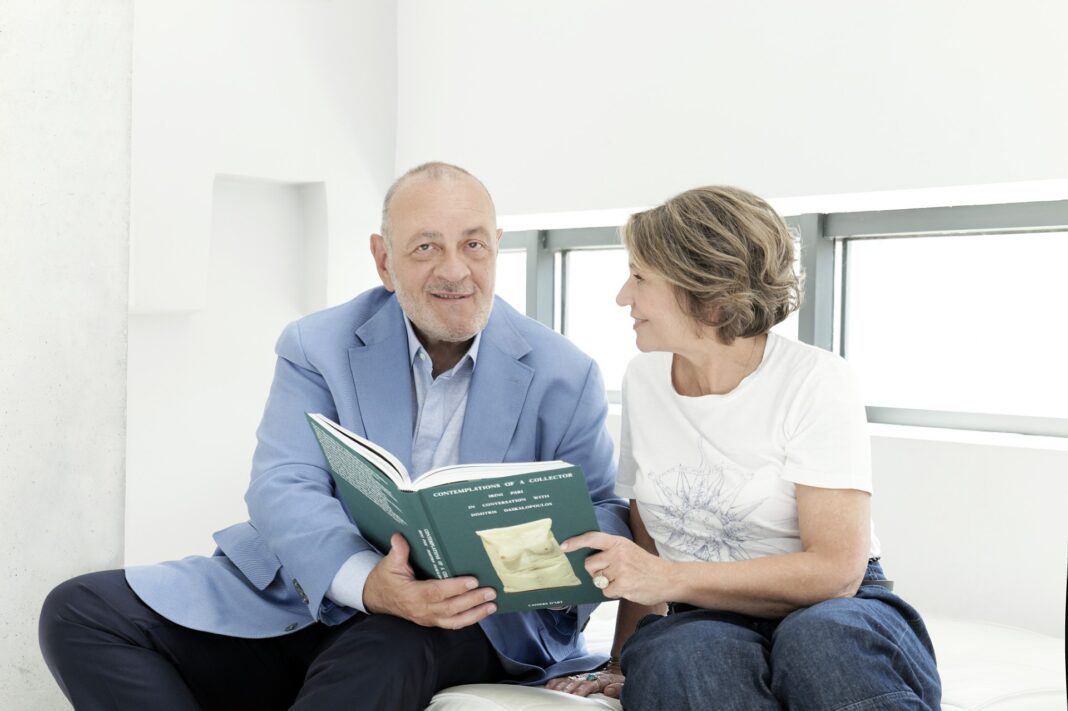Interview by Zeta Tzioti
The publication of the book *Reflections of the Collector* opens for us a window into thought, philosophy, and passion. These elements were the driving forces behind the creation of one of the most significant collections of contemporary art, that of Dimitris Daskalopoulos.
Through their conversations with journalist Zeta Tzioti, the couple shares the values, ideas, and intentions that led Dimitris Daskalopoulos to donate his collection to major museums, thus transforming a private passion into a global cultural asset.
This process is aptly captured in the book *Reflections of the Collector*, which records the conversations between Dimitris Daskalopoulos and his partner, Irini Pari, centered around one hundred selected works from his collection. The discussions evolve into a “dialogue about art and life.” This coexistence of thoughts and emotions leads to a book written by “two pairs of hands.”
The publication and presentation of this work to the public, amidst the donation of the collection, can be seen as part of the ritual farewell of the works, offering the reader a more personal and emotional dimension of this important gesture.
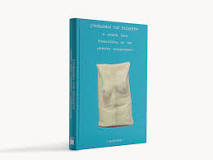
The experience of Art is multidimensional and open. This is what makes it so fascinating.
A Few Words About the Collection
The Daskalopoulos Collection, which began in 1994, includes over 350 works by 142 artists from around the world, reflecting a rich range of expressions about the human body, existential searching, and social contradictions. With works by globally acclaimed artists such as Marina Abramović, Louise Bourgeois, Mona Hatoum, Martin Kippenberger, Damien Hirst, Vlasis Kaniaris, and Despina Isaia, the collection occupies a unique position in global art.
The donation of these works to four major museums— the National Museum of Contemporary Art (EMST) in Athens, the Solomon R. Guggenheim Museums in New York, the Museum of Contemporary Art in Chicago (MCA), and Tate in the United Kingdom—created an innovative network of collaborations connecting cultural institutions worldwide, allowing the public to enjoy these precious works of contemporary art.
The book *Reflections of the Collector* is not only a record of a personal collective journey but also a profound philosophical reference to the concept of art as a fundamental human need. Dimitris Daskalopoulos notes, “Art is for everyone,” emphasizing its importance for human existence, thought, and culture.
With this donation, the collection moves from the confines of the private space to the heart of global cultural institutions, allowing everyone to engage with art and his personal view of the world.
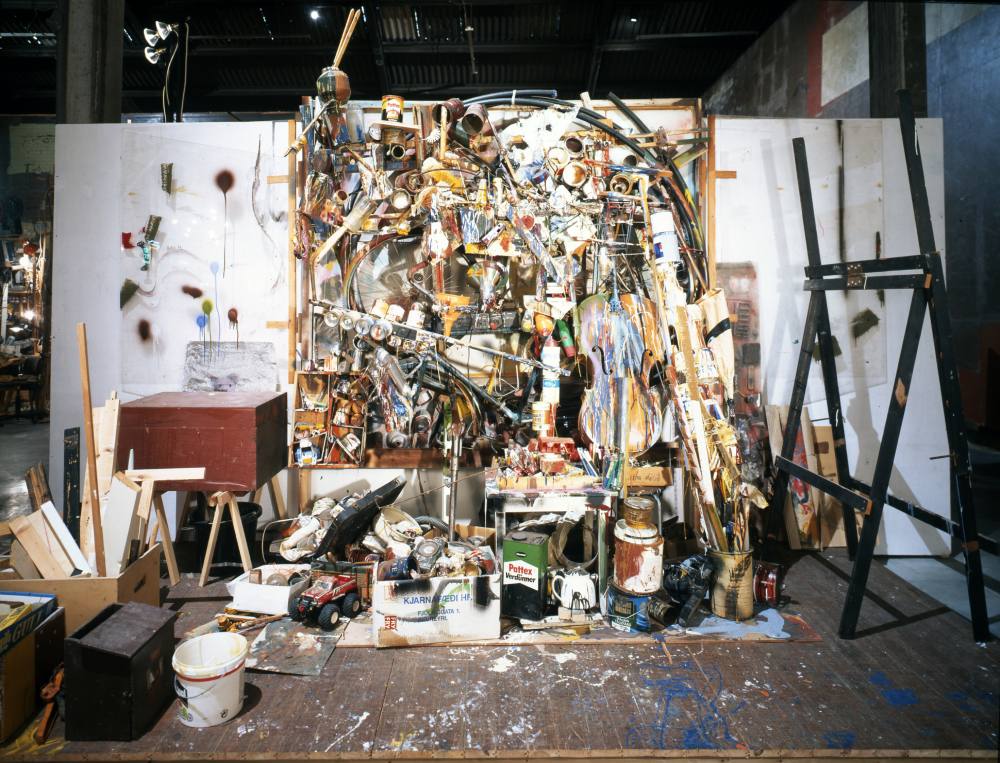
BALABILD 5′, ca 1975/2005
Mixed media on wood and on cardboard
265 × 375 × 170 cm
Gift of the D.Daskalopoulos Collection donated jointly to the Museum of Contemporary Art Chicago and the Solomon R. Guggenheim Museum
– Ms. Pari, I would like to start with you. Reading the book, we perceive that you have a special relationship with Art. How do you perceive its meaning? What does Art mean to you?
-I.P.: Art has always moved me, even though I couldn’t explain precisely why. It was something that fascinated me, something that made me feel fulfilled. I worked for many years at the European Union, with endless hours of work, negotiations, and demanding responsibilities. My personal time was limited, and I often dedicated it to visiting museums with my children. There, I felt something different — a sense of inner connection.
When I met my partner, a man who had dedicated his life to Art, I wanted to ask him what Art meant to him. He told me something that resonated deeply with me: “Art is whatever touches you and doesn’t leave you indifferent.” This answer gave me an interpretation of everything I had felt.
The more I delved into its world, the more I understood that it is a creative act that somehow imitates creation itself. Its essence isn’t limited to knowledge or technique. The mystery remains, and that is what makes a work of Art stand out. It’s not just colors or materials. It is the power that moves you, that makes you feel awe, that stirs you internally.
A work of Art doesn’t “speak” only to us. It can touch every person in a different way, but with the same intensity. And this pulse, this experience, is timeless. It transcends the eras, unites human experiences, touches something deeper: nature, humanity, the mystery of existence, the Universe itself.
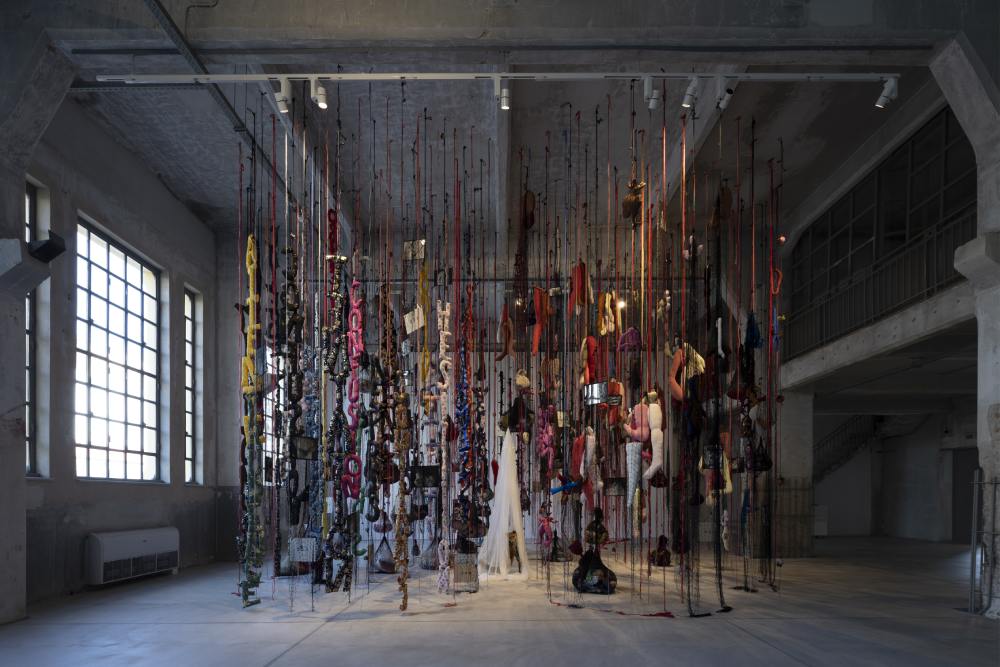
DEPENDANCE / INDEPENDENCE, 1995
Fabric, black-and-white photographs, wool, ropes, fishnet stockings, stuffed animals, netting, plastic, and lamps
Dimensions variable
EMST. Presented as part of the D.Daskalopoulos Collection Gift
– Mr. Daskalopoulos, you often refer to this “pulse,” the shiver that overtakes you when viewing a work of Art. Is this what led you to the decision to donate?
–D.D.: Exactly. This deep feeling, this emotional and intellectual experience that Art provokes, was the driving force behind my decision. I don’t feel like the owner of a collection; I feel like I am simply an intermediary, a guardian of works that have the power to inspire, to move, to awaken.
That’s why I believed these works should belong to the public. Art is essential. It is a fundamental human need — not a luxury. And it should be accessible to everyone.
– Have you always been interested in modern art, or did you start your journey through the great classical creators?
-D.D.: In art, there are no boundaries—nor should there be. Of course, when we talk about a collection, there needs to be a specific concept, cohesion, and structure. But the love for art doesn’t get limited to categories or genres. Art in all its expressions moves and inspires us.
As art lovers, we will visit museums with permanent collections that tell the story of human creativity, highlighting great achievements and providing a broader cultural framework. At the same time, we won’t skip the temporary exhibitions and contemporary galleries, where you encounter the most vibrant and immediate aspect of art—with works that are often accompanied by the presence of the artists themselves, with whom one can converse and exchange thoughts.
The experience of art is multi-dimensional and open. That’s what makes it so fascinating.
–E.P.: The ancient Greek statues, like the Venus de Milo or the Winged Victory of Samothrace, along with Richter’s paintings, for me, are “one.” They are connected and form an indivisible part of art.
While writing the book, I realized that over the last 30 years, my partner has built a collection of contemporary art with works by international artists, the main theme of which concerns the human being, creativity, anxiety, fragility, life, and death.
Although I don’t believe this was something he consciously aimed for, I think his collection has a deep Greek influence. The central element is the human being, and this is the core that Greek civilization brought to humanity.
This is exactly what Jacqueline De Romilly describes in her book *”Why Greece?”*, where she so aptly explains her dedication to studying and promoting Greek letters. In her condensed reference, she traverses the entire spectrum of the Greek miracle—from Homer and Pindar to the zenith of the 5th century in Athens, mainly through the texts of history, tragedy, and philosophy.
Although there were other great civilizations before the Greek, the innovation brought by Greek civilization was essential. In art, for example, Greek statues depicted the human form in a way that was closer to human nature than many other representations. They were not gigantic. Everything was made to human proportions. Even the twelve gods had human virtues and flaws.
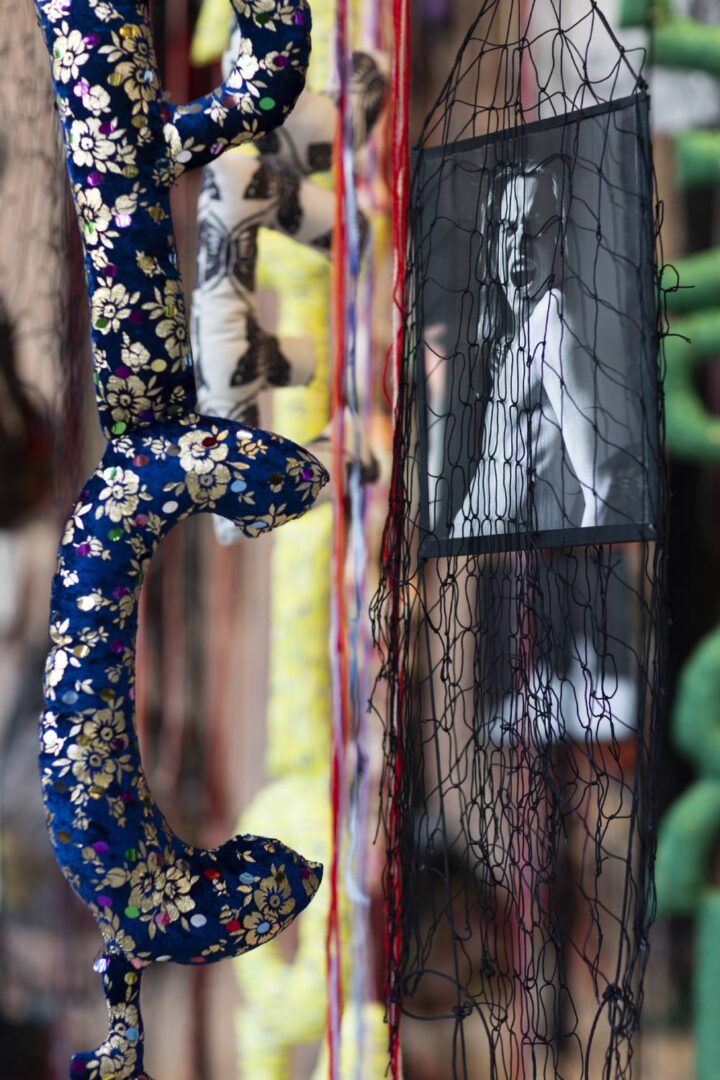
DEPENDANCE / INDEPENDENCE, 1995
Fabric, black-and-white photographs, wool, ropes, fishnet stockings, stuffed animals, netting, plastic, and lamps
Dimensions variable
EMST. Presented as part of the D.Daskalopoulos Collection Gift
– How did the idea for the creation and, eventually, the publication of this introspective and multi-dimensional book come about?
–E.P.: Without the love for art, none of this would have happened. If Dimitris hadn’t had his immense love for art, he would never have started his collection. If I didn’t love him, his art, and this collection, this book would never have been born.
One day, around a round table, I asked my partner to go deeper and discuss his collection. We started talking in detail about each work, and what he was telling me was so beautiful that I thought these reflections needed to be recorded and shared. That’s when I began taking notes on my iPad.
The idea for the book was born in that moment. I wanted to create something that would serve as a legacy for his children and grandchildren, something that would accompany his collection and give it its true dimension.
After two years of preparation and ongoing discussions, I concluded the structure of the book.
In Part A, we discuss why and how one becomes a collector. What drives them to start such a journey, and what is the meaning of collecting?
In Part B, we examine the themes of the collection and the individual topics it addresses. We take a thoughtful walk through the works and the concepts that make up the collection.
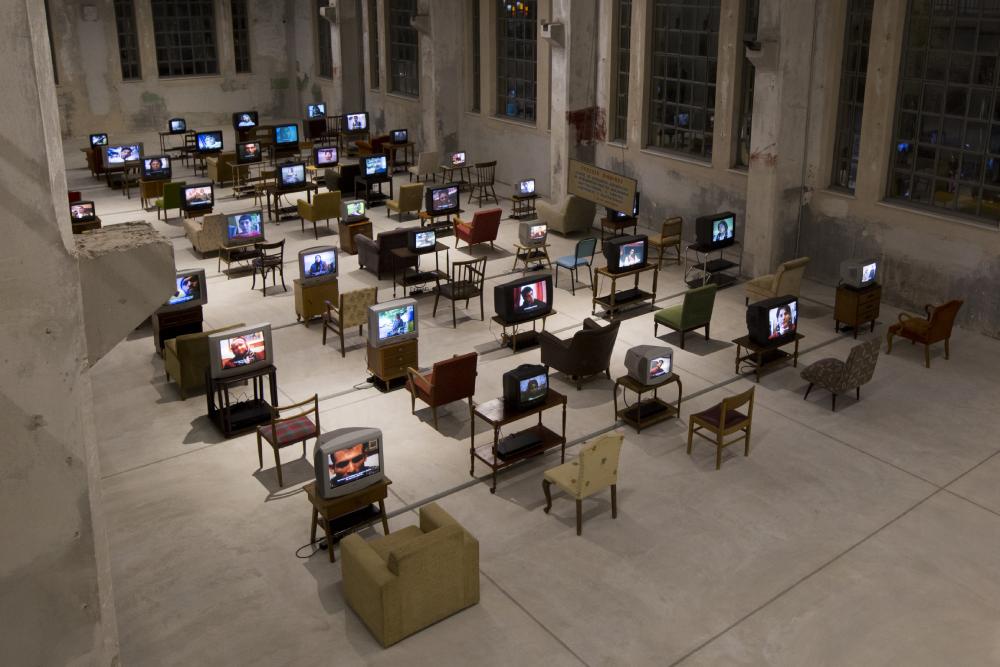
KUBA, 2004
40 channel video installation with sound
Variable dimensions
EMST. Presented as part of the D.Daskalopoulos Collection Gift
– Mr. Daskalopoulos, you are undeniably an exceptionally successful entrepreneur. How did you decide to publish a book that is not only an expression of your love for art but also an honest dialogue with your wife about it?
-D.D.: I won’t hide the fact that, initially, I had some reservations about publishing it because for me, it was a sincere exhibition of my soul. However, now I’m very happy that this book exists and accompanies the collection.
I realize that with the donation of the works to museums, the book takes on special value, as it’s not just a record of the works, but also a personal testimony to their significance. Especially when the works are exhibited in public spaces, the book serves as a tool for understanding the collection, its history, and the emotions tied to it, offering viewers a deeper way to approach art and understand the role it plays in our lives.
-Mrs. Pari, the book delves into the concept of the Collection and the emotions of the collector. Considering the donation of the Collection to museums, do you consider the book’s value to be enhanced? How do you perceive its role in this context?
-E.P.: Of course. The book has proven useful for us as it helped us structure our thoughts and the process behind the decision to donate, but also our personal journey as art lovers.
We also wanted to share our thoughts on what we love and admire, not only with people for whom art is equally important, but also with the hope that we might reach those who, when visiting exhibitions, comment things like “I don’t understand” or “I could do this too.”
This book aimed to share our perspective on the significance behind each work and the essence of artistic creation, hopefully encouraging those people to free themselves from the need to understand with their minds and to open their hearts and wander in the allure of art.
-D.D.: Besides all of this, both of us believe that art could soften the soul, sharpen the mind, and make us more curious. It’s a tool that encourages us to explore new ideas, reconsider the world around us, and enhance our personal, as well as professional, growth.
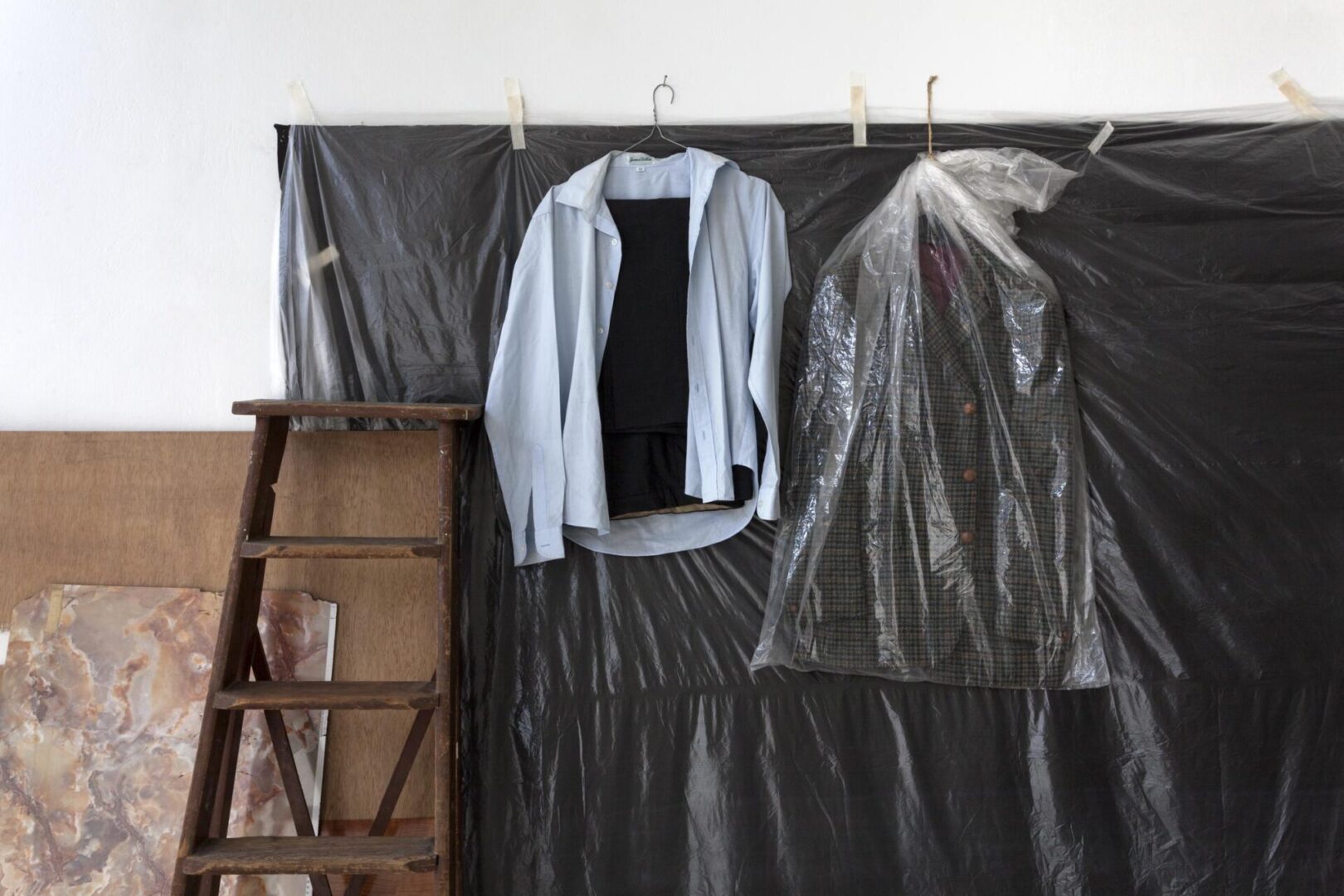
POSSIBLE BACKGROUND (ΠΙΘΑΝΟ ΦΟΝΤΟ), 1974
Mixed media
225 × 540 × 110 cm
Tate. Presented as part of the D.Daskalopoulos Collection Gift 2023
– Is there any artwork in your collection that holds personal emotional value for you, even though it might not be considered a masterpiece by art critics?
-D.D.: First, I believe that all the works in the collection have personal emotional value for me. They moved me when I saw them, I considered them valuable and fitting for the collection, and they still touch me when I see them today. Only time and the evolution of art and society will determine which works will be recognized as masterpieces and which won’t.
– Is there any artwork that made you change your opinion on a social or political issue?
-D.D.: Art, especially contemporary art, does not aim to express strong opinions or comment on major, current issues. Artists do not provide immediate solutions, but rather create sensitivities in people, helping them to function better as members of society. I don’t believe that art shows us the future or makes groundbreaking proposals.
On the contrary, it encourages us to wonder and examine questions, giving us stimuli for thought. There isn’t a work that changed my opinion, but my relationship with art has helped me find answers or think more creatively in all areas of my life.
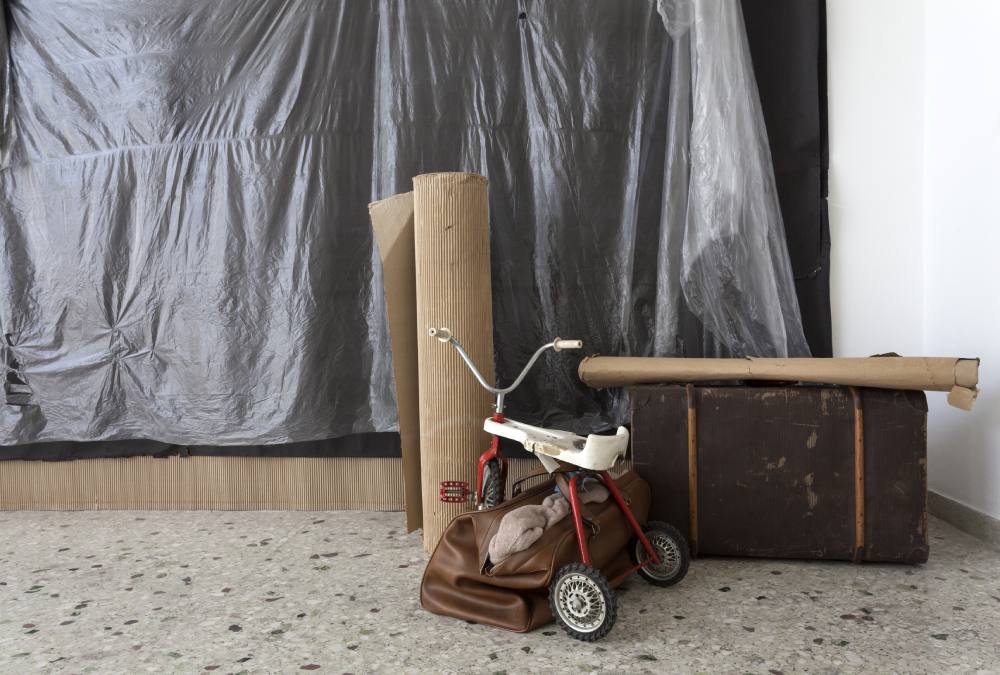
POSSIBLE BACKGROUND (ΠΙΘΑΝΟ ΦΟΝΤΟ), 1974
Mixed media
225 × 540 × 110 cm
Tate. Presented as part of the D.Daskalopoulos Collection Gift 2023
-If you had the opportunity to have a ‘fantastic’ conversation with any artist from history, who would you choose and what questions would you ask them?
-D.D.: If I had to choose, I would pick either Rubens or Marcel Duchamp. But I wouldn’t say much. I would simply express a sincere “thank you” on my behalf and on behalf of humanity. I believe the entire world owes them gratitude for their work. And then, I would leave.
-E.P.: I would choose Phidias, because I am moved by the way he brought art into human dimensions.
I think this artist forever changed the way we perceive art, especially with the creation of works that combined both divine and human aspects, like the statue of Athena Parthenos and the statue of Zeus at Olympia. His technique, his ability to turn materials like gold and ivory into living forms, showed us a new perception of beauty and form, opening new paths for art.
–Mrs. Pari, considering all that your husband has contributed to the world of art, could he be regarded as a guardian of innovative ideas and human creativity, with the central aim of conveying meaningful messages through art? As his partner in this journey, how would you reflect on this perspective?”
-E.P.: That’s very flattering and humble, but Dimitris never sees himself that way. He views his collection as a personal journey, a natural expression of his interest in art and life. Even though the donation of the works to museums is an action that certainly contributes to the dissemination of the messages that art holds, he would say that the “fulfillment” of his work is nothing more than the act of offering the works to the world, without any expectation of recognition or reward.
It’s a balance between private collecting and the public dimension of the works—a process in which, personally, I see Dimitris as a “mediator” between art and the public that enjoys it. If anything matters to him, it’s that art remains alive and accessible to everyone—regardless of age, social status, or academic background.
Art, as he always says, is not just for experts, it’s for everyone. And that’s why his donation of the collection to museums is a move that feels, to him, almost inevitable, though it’s simultaneously extremely generous.

CURRENT DISTURBANCE, 1996
Wood, wire mesh, light bulbs, computerized dimmer switch, amplifier, four speakers
279 × 550,5 × 504 cm
Tate. Presented as part of the D.Daskalopoulos Collection Gift 2023
– Mr. Daskalopoulos, have you ever made an unconventional business decision inspired by the influence of art?
-D.D: I believe that the success and progress of my business were positively influenced by my parallel involvement with art. When I took on more intensive and responsible management of the business, it was also the time I started creating my contemporary art collection.
Although the two may seem unrelated – the business, which is about money, and art, which is more connected to aesthetics – for me, this coexistence made me bolder and more curious. In fact, at the time I started getting more involved in art, I was also dealing with difficult business projects that marked my work.
Earlier you asked me what I would do if an art expert advised me against buying a particular piece. I did the same thing in my business as I did in art. Specifically, at the same time, advertising experts advised me not to put Life juice in black packaging and not to write the letters vertically on the box, but to place them horizontally.
Instead of following their advice, we did the exact opposite: we launched Life in black packaging with the letters vertically, and this turned out to be the boldest design we could have made. And in the end, it was an incredible success.
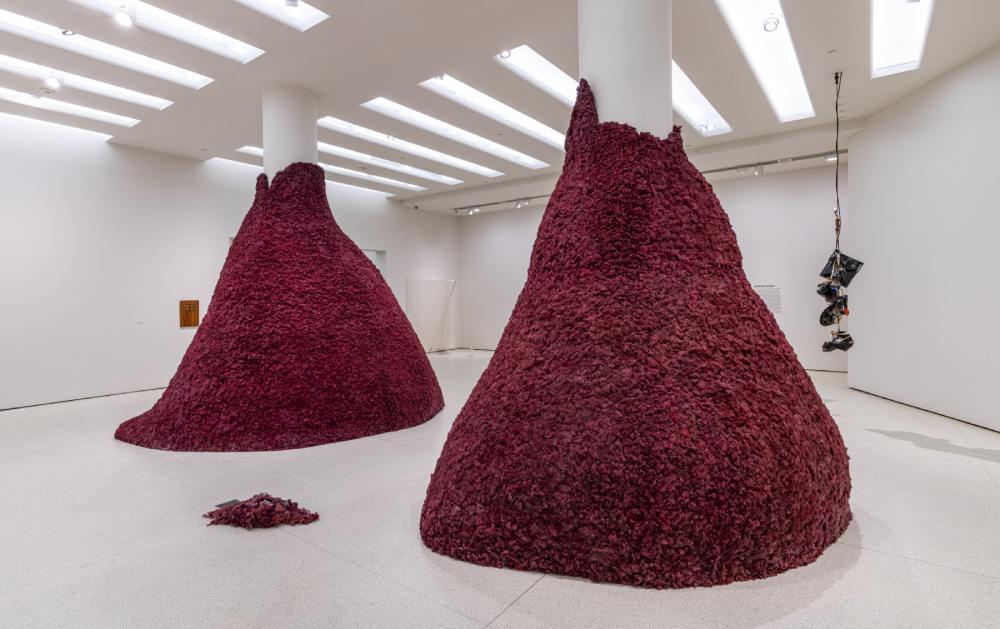
OH! HAPPY DAYS, 2012
Polyurethane foam, polyester fiber, and acrylic latex paint
Variable dimensions
Gift of the D.Daskalopoulos Collection donated jointly to the Museum of Contemporary Art Chicago and the Solomon R. Guggenheim Museum
– You donated your collection to four major museums on two continents, and it took several years for you to make the decision and complete the process. From your side, you requested the obvious without unjustified demands. Do you believe, in general, that the terms set by collectors in their donations help museums in their evolution?
-D.D: I answer through action. I believe that the terms of collectors are restrictive and negative for the works, the artists, and the public. Personally, I never set any conditions. I wrote a simple letter stating: “I am willing to donate these works, I believe in your work, and I would like them to be seen by the public, to become part of your educational program. Have a good day.”
I have participated in museum boards, where members of the board had to call lawyers to check if the laws of the artist or the institution allowed this or that act, and this is bad because it diverts the museum from its main purpose, which is to freely present the works of artists to the public.
-E.P: Dimitris, this is very beautiful because, essentially, it is based on trust. You chose the custodians of your collection because you trust them, believing they have the knowledge to manage it in the future.
-D.D: What we are living now is the confirmation of how positive this was for the works. Now, for example, in London, there are 30-35 works from the donation on display at Tate, presented in the best possible way. They are presented with new dialogues, in dedicated rooms, in combination with other works. The curators seem to be constantly striving. They were so happy with the gift they received and the trust that was given to them, that they are thinking about what the next step will be.
And what excites us the most is that we are not involved at all. We never told them, “This piece should be placed like this or like that.” When you give trust, the other person thrives. The museum’s mechanisms could approach the most capable people.
A collector cannot have the illusion that they made the greatest collection and that only they know what is beautiful and fits in their collection. The museum itself, the knowledge of the people, and time will judge the works.
Also, at the EMST, the works from the donation have already been highlighted and used excellently. Katerina Gregos and her team are doing a great job.
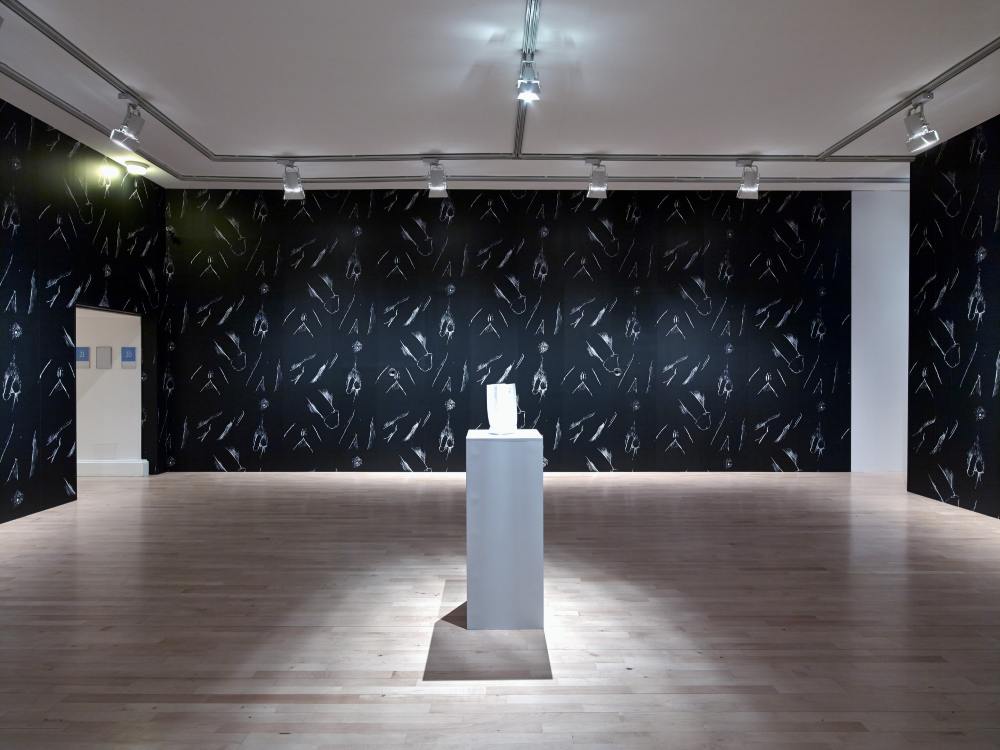
UNTITLED, 1989
Installation of 3 elements :
DRAIN, 1989/2006: Cast pewter, 11 cm (diam.) × 8 cm (deep)
BAG OF DONUTS, 1989: Acid free hand cut paper, graphite, dough, synthetic resin, 28 × 17 × 15 cm
MALE AND FEMALE GENITAL WALLPAPER, 1989: Hand printed silkscreen on paper, each roll: 61cm (wide) × 14m (long), cut to 5m or 9 m (long)
Variable dimensions
Tate. Presented as part of the D.Daskalopoulos Collection Gift 2023
– In your book, you mention that your collection is complete. When does a collector reach the true completion of their collection? Is it the moment they acquire the last piece, or when they feel they no longer need anything else? Is completion an objective state, or something that someone feels within themselves? Do you think new works of art will appear that you would want to acquire?
-D.D: I’m not an artist, but I consider the creation of the collection itself to be a work of art. Painters and sculptors “alter” their work constantly. They add, they subtract, and when they reach a point, they say, “this is it, it’s finished,” and they set it aside.
This is what happened with me and the collection. Because this collection was about man, his creative ability, and his struggle in life, at some point I felt that any new addition would be superfluous, like “unnecessary words.” Now, if we buy something, it’s works that we like and want to see in the space where we live. However, the greatest joy comes from the many beautiful objects and works of art we see in great museums, and where the endless artistic creativity is displayed, rather than from the few that can belong to us.
-E.P: It’s true that our lives revolve around art, whether it’s in books or events. It’s nourishment for us, always something that inspires us and fills us up.
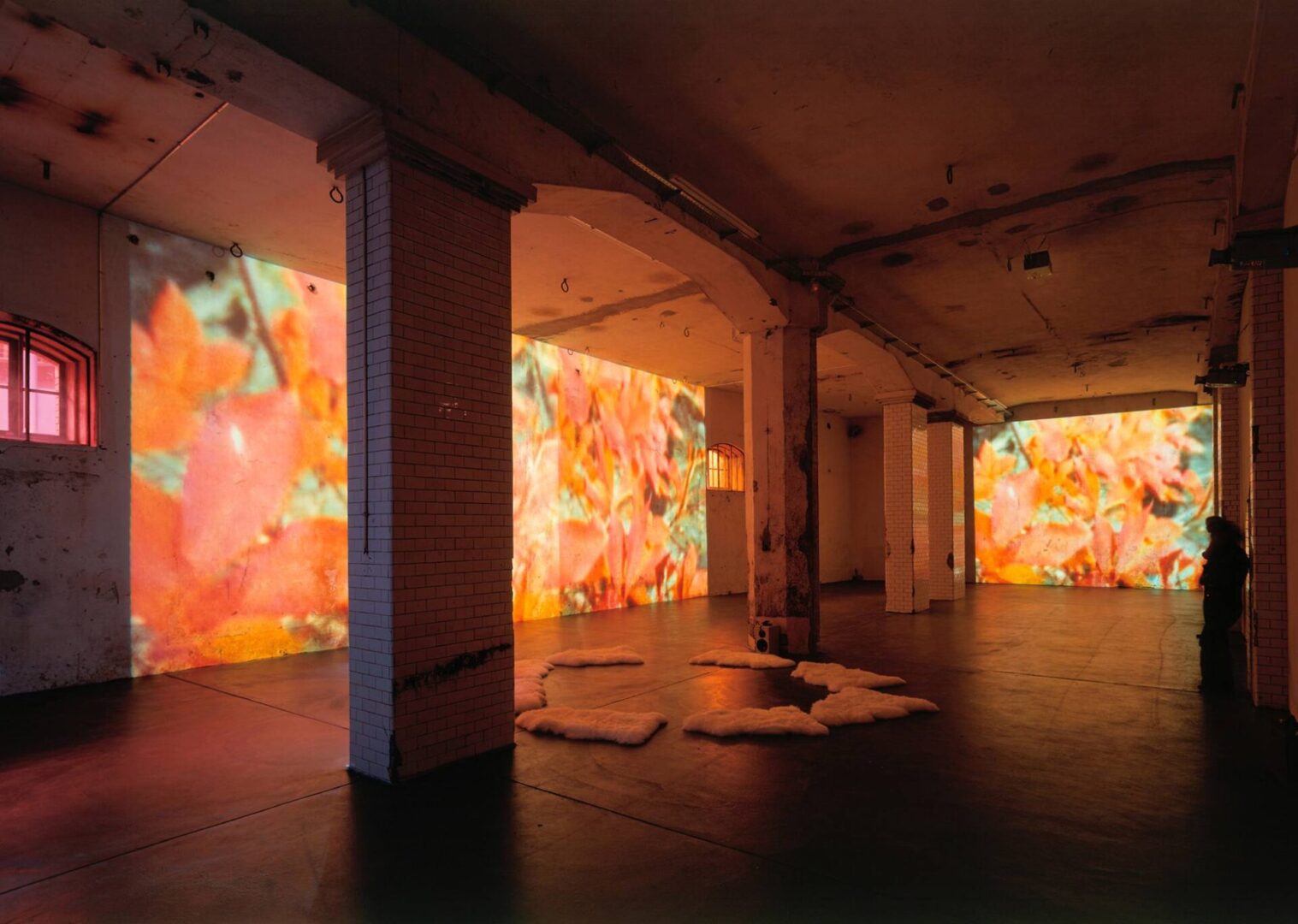
SUPERSUBJEKTIV, 2001
Video installation, sheepskins
Variable dimensions
Gift of the D.Daskalopoulos Collection donated jointly to the Museum of Contemporary Art Chicago and the Solomon R. Guggenheim Museum
– Could you imagine a future where your collection consists not of physical objects but of digital works of art in changing environments?
-D.D: Since I’ve always been interested in the future and evolution, I seek to explore what artists are doing with new tools. However, for now, what I observe is that artists are using new tools to create art in the same way they always have. I haven’t seen the digital world offer a radically new approach.
All the works we see, if you ask me, are like saying, “Before, we went from one place to another with a cart, now we do it with a car, and later with an airplane.” Nothing fundamentally has changed in art through technology.
I have yet to see artificial intelligence create something that could be considered remarkable or something that could benefit society. However, this might change when artificial intelligence begins to integrate into the human body, becoming part of human existence, something I believe will happen at some point.
It will no longer be us, humans, and these machines. It will be a whole, something unified. Perhaps we haven’t yet found the Marcel Duchamp of artificial intelligence.
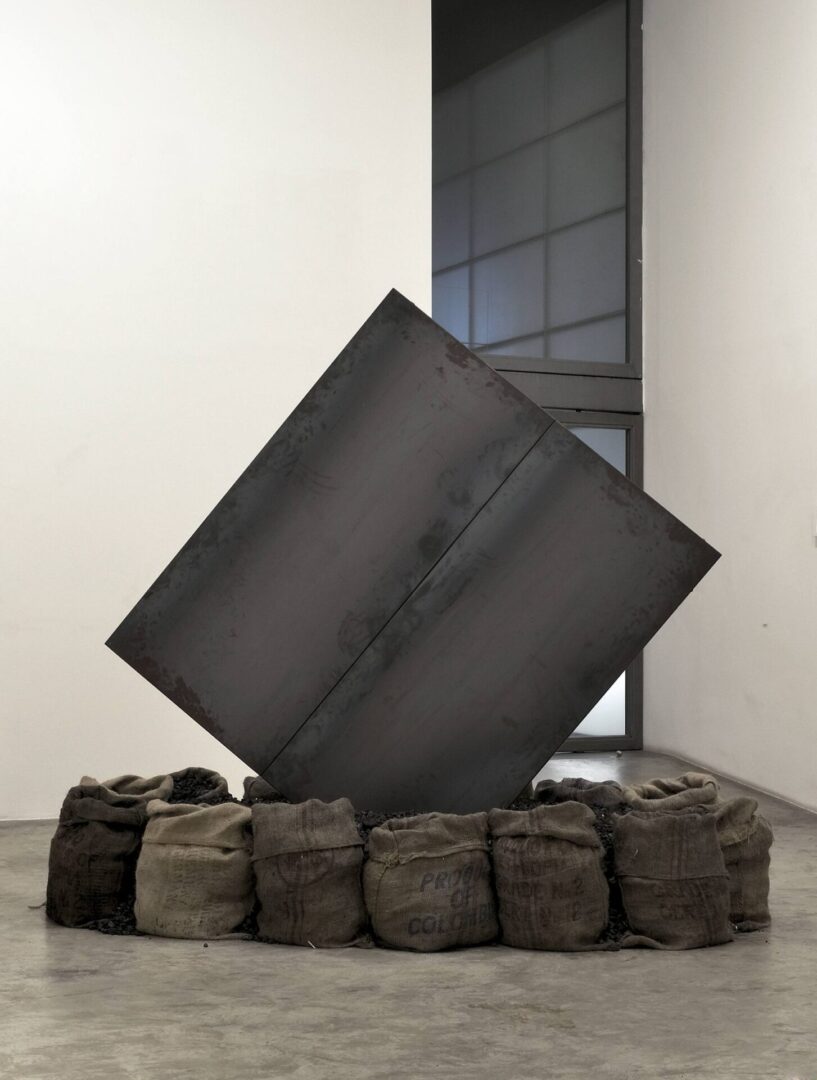
UNTITLED, 1993
Coal in burlap sacks, steel plate
Overall: 270 × (diam.) 250 cm
Gift of the D.Daskalopoulos Collection donated jointly to the Museum of Contemporary Art Chicago and the Solomon R. Guggenheim Museum
– Would you ever decide to convert any of your works into NFTs?
-D.D: No, never. A work of art has this dimension of the six senses, which you only experience when you are close to the work, in a space. Only then can you see it and feel it holistically. You cannot feel or absorb the same experience through a screen or a reproduction. For me, art is something that is lived directly, with all the senses, and this is impossible to reproduce in digital form. I would consider it impossible at this stage.
However, if technology evolves in a way that takes us into a new world, where we see things, we can’t even imagine, maybe then it will be different.
-How would you advise a new collector to approach building a meaningful art collection, considering it as a journey rather than a destination?
-D.D: The first and most important advice is to follow their passion and their own sense of taste. They should not view it as an investment, because if they do, they will lose the essence and the real interest in art. And, of course, not to listen to too many others. If they try to create something that follows the dictates of others, the result will be lukewarm and indifferent, and it won’t be representative of themselves.
-E.P: In Berlin, for example, where we were recently, we saw many collectors, museums, and institutions, and it’s truly impressive how different and unique each collector can be if they follow their own path and their own thinking. They create something so special and unique.
As Dimitris said earlier, it’s like creating a work of art themselves. Each collection, essentially, is a new creation, a new dialogue between the works, formed through the soul of the collector and carrying their personal imprint.
-D.D: We have seen collections that may not fit our tastes, but what we always admire is the passion and dedication of those people. And that is the most important thing. Ultimately, all collectors share one common trait: a deep passion and love for art.
-When selecting a work of art, do you prioritize the artist’s reputation or the intrinsic qualities of the artwork itself?
-D.D: For me, the most important thing is the work itself. I believe that the work should “emit,” it should have its own power. When the work has this ability, then within it passes the thought and energy of the artist. It is not necessary to personally know the artist. If the work has the power to touch the viewer, it means that the artist has managed to leave their mark this way, through their art.
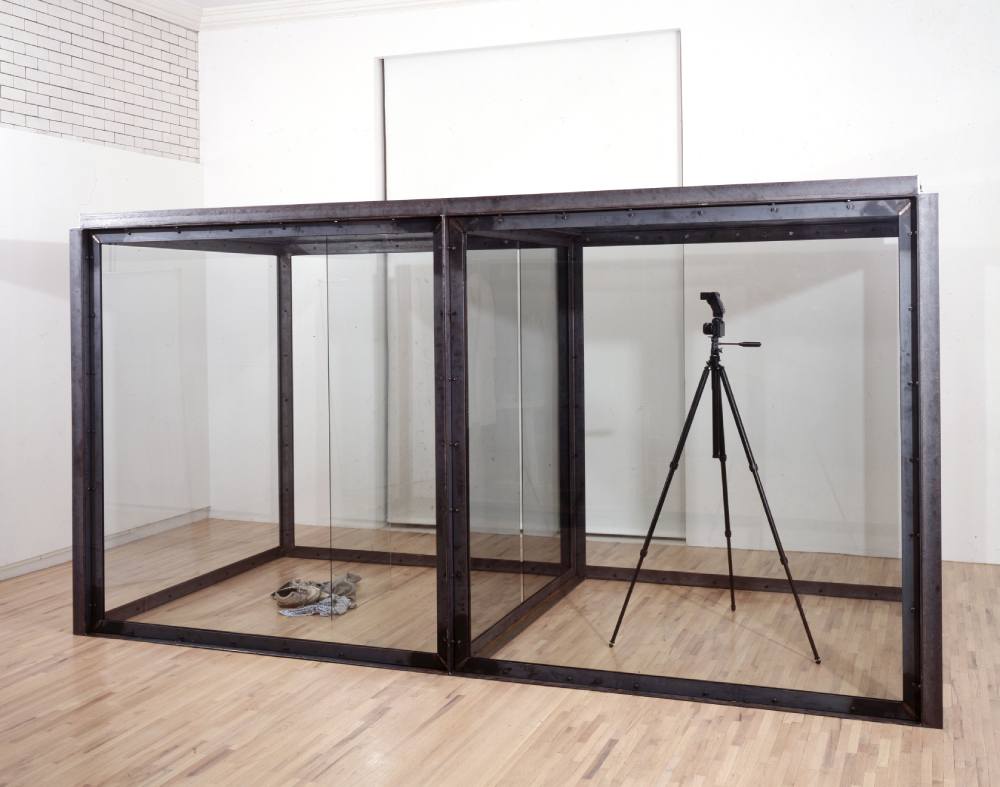
THE ASTHMATIC ESCAPED I, 1992
Mixed media
Painting: 92 × 138 cm
Sculpture: 427 × 214 cm
Tate. Presented as part of the D.Daskalopoulos Collection Gift 2023
– Mr. Daskalopoulos, as experienced collector, would you encourage young artists to dedicate themselves fully to art?
-D.D: It is natural for people to strive for progress, and competition, especially in the field of art and creativity, is indeed intense. This space is full of talent and innovative ideas, and recognition is difficult, as the field is vast and constantly evolving.
My advice to someone trying to stand out in this field is to keep creating and evolving, but with a realistic approach. Art is not only passion and creativity but also a means of survival. It is essential to find ways to support themselves financially, whether through their art or other activities that provide stability. Strong will and persistence are crucial, but equally important is the ability to understand practical needs and remain grounded.
Art is an immense world full of creativity, but to survive and evolve in this world, you need a strategy that combines your artistic expression with the practical needs of daily life.
-E.P: When someone has this “vein” of creativity inside them, it is almost impossible to ignore it. Art, the need for expression and creation, pulses within them, driving them to follow it, even when the path is filled with difficulties and doubts. As you rightly point out, the artist’s journey is full of anxiety and insecurity because, despite this irresistible need to create, the artist often finds themselves at a dead end, in a world that does not always recognize the value of this need.
As Dimitris says, art is a right and an inseparable part of human existence. However, society often does not appreciate it in its full dimension. Even though art can enrich our lives and bring us closer to the essence of the world, it is often considered less important than other activities, mainly because society focuses on more “practical” and economically beneficial professions.
This contradiction creates a paradox: art is fundamental to human nature, but it often does not receive the recognition or support it deserves. It is a path filled with uncertainties and difficult moments, but artists continue to try because their art is something they cannot deny—it is part of their very being.
– You are very actively and effectively involved in entrepreneurship and Art. What do you think the art evolution will be? How could you imagine the post-art era?
-D.D: I think the evolution of technology will bring something we cannot yet imagine. Something that has happened again in the history of art, in the distant past, that changed the course of things, marking a new era.
I believe we will see the emergence of a new era, one that will preserve the core of human creativity, that “nuclear energy” which constitutes the essence of art, but will provide new possibilities for humans with means and methods that we cannot even perceive today.
-E.P: I’m not sure I would call it “post-art” or whether it’s just the evolution of art. For me, art is an ongoing thread, without boundaries, constantly evolving, because it is a fundamental human need.
From the first paintings on cave walls, to the Pharaohs and the Parthenon, all the way to Duchamp, art has always moved forward, without being limited by time or form. It is what makes the “strings of the universe” vibrate. It’s something deeper, something that goes beyond full understanding, and its value constantly transforms with its evolution.
I would like to thank Mrs. Pari and Mr. Daskalopoulos for this insightful and in-depth interview about Art.
Z.T


